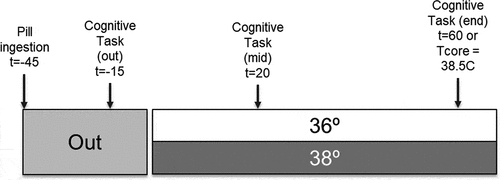Figures & data
Table 1. Participant characteristics, values are mean ± SD
Figure 1. Timeline of the protocol, participants take the pill 45 min before start entering bath; thereafter, participants are prepared and practice the cognitive tests. At T = −15 the experiment starts outside the bath and continues at T = 0 inside the bath. Twenty minutes after entering the bath (T = 20) the second bout of the cognitive tests takes place. Then, either after 60 min in the bath, or when gastrointestinal temperature (Tcore) reaches 38.5°C participants start with the final bout of the cognitive tests. Thereafter, the experiment is finished and participants carefully leave the bath

Table 2. Descriptives (mean and standard deviation) of objective, subjective, and physiological outcome variables. Asterisks indicate a significant difference with the first bout (out of bath baseline) in the same condition (p < 0.05 = *, p < 0.01 = **, p < 0.001 = ***). Diamonds indicate a significant difference with the corresponding neutral condition (p < 0.05 = ◊, p < 0.01 = ◊◊, p < 0.001 = ◊◊◊). Objective cognitive measures are reported in [Citation10], yet repeated in this table for completeness
Table 3. Stepwise linear regression models on objective cognitive performance. Number between brackets indicates the order of entry
Figure 2. Mean±SD change of objective, subjective, and physiological outcome variables in neutral (blue) and warm condition (red) normalized vs. baseline. [C]: significant effect of condition (p < 0.05), [T]: significant effect of time (p < 0.05), [CxT]: significant interaction effect (p < 0.05). N = 27 for response time, accuracy, and estimation of time, n = 19 for gastrointestinal temperature (GI), n = 23 for heart rate, n = 26 for NASA-TLX, n = 19 for thermal sensation and n = 17 for thermal comfort
![Figure 2. Mean±SD change of objective, subjective, and physiological outcome variables in neutral (blue) and warm condition (red) normalized vs. baseline. [C]: significant effect of condition (p < 0.05), [T]: significant effect of time (p < 0.05), [CxT]: significant interaction effect (p < 0.05). N = 27 for response time, accuracy, and estimation of time, n = 19 for gastrointestinal temperature (GI), n = 23 for heart rate, n = 26 for NASA-TLX, n = 19 for thermal sensation and n = 17 for thermal comfort](/cms/asset/9959b897-12fb-405a-a576-047af6eb7bc5/ktmp_a_1776925_f0002_oc.jpg)
